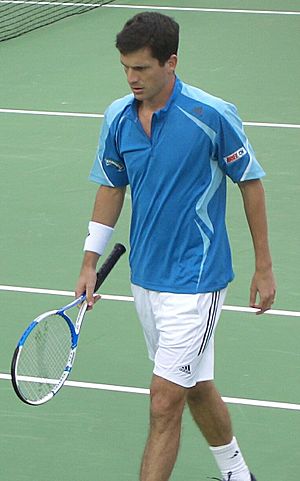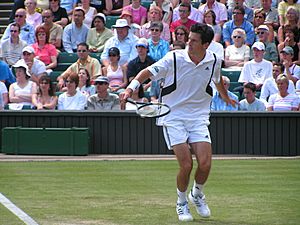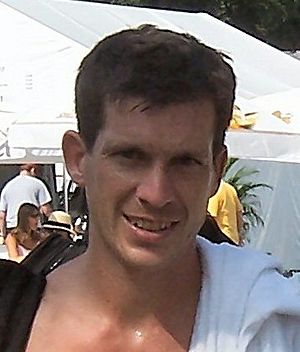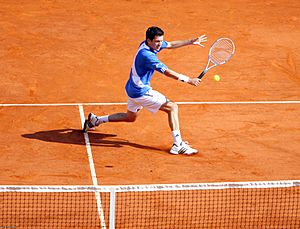Tim Henman facts for kids
 |
|||||||||||
| Full name | Timothy Henry Henman | ||||||||||
|---|---|---|---|---|---|---|---|---|---|---|---|
| Country (sports) | |||||||||||
| Residence | Aston Tirrold, Oxfordshire, England | ||||||||||
| Born | 6 September 1974 Oxford, England |
||||||||||
| Height | 6 ft 1 in (1.85 m) | ||||||||||
| Turned pro | 1993 (amateur tour from 1992) | ||||||||||
| Retired | 2007 | ||||||||||
| Plays | Right-handed (one-handed backhand) | ||||||||||
| Coach | David Felgate (1992–2001) Larry Stefanki (2001–2003) Paul Annacone (2003–2007) |
||||||||||
| Prize money | $11,635,542 | ||||||||||
| Singles | |||||||||||
| Career record | 496–274 (64.42%) | ||||||||||
| Career titles | 11 | ||||||||||
| Highest ranking | No. 4 (8 July 2002) | ||||||||||
| Grand Slam singles results | |||||||||||
| Australian Open | 4R (2000, 2001, 2002) | ||||||||||
| French Open | SF (2004) | ||||||||||
| Wimbledon | SF (1998, 1999, 2001, 2002) | ||||||||||
| US Open | SF (2004) | ||||||||||
| Other tournaments | |||||||||||
| Tour Finals | SF (1998) | ||||||||||
| Grand Slam Cup | SF (1996) | ||||||||||
| Olympic Games | 2R (1996) | ||||||||||
| Doubles | |||||||||||
| Career record | 89–81 | ||||||||||
| Career titles | 4 | ||||||||||
| Highest ranking | No. 62 (21 February 2000) | ||||||||||
| Grand Slam doubles results | |||||||||||
| Australian Open | 1R (1996, 1997, 1998) | ||||||||||
| French Open | 3R (1996) | ||||||||||
| Wimbledon | 2R (1994) | ||||||||||
| US Open | 2R (1996) | ||||||||||
| Other doubles tournaments | |||||||||||
|
Medal record
|
|||||||||||
Timothy Henry Henman (born September 6, 1974) is a famous British tennis player who used to play professionally. He was once ranked as high as No. 4 in the world for men's tennis in the early 2000s. Tim won 15 big tennis titles in his career: 11 in singles and 4 in doubles. This included a major win at the Paris Masters in 2003.
Henman was known for his "serve-and-volley" style of play. He was the first British man to reach the semifinals at Wimbledon since the 1970s. He made it to six major tournament semifinals and had a great record playing for the Great Britain Davis Cup team.
Tim was the top British player in 1996 and again from 1999 to 2005. He is one of the most successful British players in the modern era of tennis. He earned over $11 million in prize money. In 2004, he was given an OBE award for his achievements.
Henman started playing tennis before he was three years old. He began serious training at age eleven. After a bad injury that affected him for two years, he started playing in junior tournaments around the world. He quickly moved up the professional rankings. By 1996, he reached the quarterfinals at Wimbledon.
For most of his career, Tim was considered a specialist on grass courts. He reached four Wimbledon semifinals between 1998 and 2002. He also did very well on hard courts early on. Later in his career, he became good on clay courts too. In 2004, he reached the semifinals of the French Open. Henman stopped playing professional tennis in late 2007. However, he still plays in the ATP Champions Tour, which is for former professional players.
Contents
Growing Up and Starting Tennis
Tim Henman was born in Oxford, England. He was the youngest of three boys. His father, Anthony, was good at many sports, including tennis. His mother, Jane, was a dress designer and played junior Wimbledon. She introduced Tim and his older brothers to tennis very early on their family's grass court.
Tim's great-grandfather also played at Wimbledon. His maternal grandfather, Henry Billington, played at Wimbledon from 1948 to 1951. He also played for Britain in the Davis Cup. Tim's maternal great-grandmother, Ellen Stanwell-Brown, was said to be the first woman to serve overarm at Wimbledon in 1901. His maternal grandmother, Susan Billington, played mixed doubles on Centre Court at Wimbledon in the 1950s.
Tim grew up in Weston-on-the-Green, a small village in Oxfordshire. The family had a grass tennis court in their backyard. Tim started playing tennis before he was three years old with a small squash racket. He taught himself how to serve and volley even then. Early in his life, Tim thought if tennis didn't work out, he would become a golfer.
He went to the Longbridge School and then the private Dragon School in Oxford. He was excellent at all sports but best at tennis. In 1985, he became the school's tennis captain. He led the team to win 21 out of 27 matches. He is the only student who won both the junior and senior tennis tournaments in the same year.
From age eight, Tim was coached at the David Lloyd Tennis Centre. His coach, Onny Parun, said Tim's greatest strength was always his mind. David Lloyd also noticed Tim's mental toughness.
Tim later received a scholarship to Reed's School in Cobham, Surrey. David Lloyd convinced Tim's parents to let him focus on a tennis career. They understood that you can always go back to school later, but a serious tennis career needs to start early.
At age 11, Tim joined the Slater Squad. This group helped young tennis players. The goal was to coach players from a younger age than the Lawn Tennis Association (LTA) usually did. Tim worked on tennis three hours a day. He spent two hours playing and getting advice, and one hour on gymnastics and learning about the game.
At first, Tim was not seen as the best player in the squad. Sue Barker, a famous British tennis player, said he didn't have natural tennis skills but was a "hard worker." Other players didn't think he would become the British number one.
Soon after joining, Tim was diagnosed with osteochondritis, a bone disease. He couldn't play tennis for six months. It took two years before he could play in tournaments again. Luckily, the Slater Squad kept supporting him because David Lloyd believed in his talent.
Tim passed ten GCSE exams at Reed's School. At 16, he told his mother he couldn't keep up good grades and tennis at the same time. In 1990, he left school to focus on becoming a singles player. Even though some thought he was better at doubles, Tim wanted to play singles. In 1991, he started playing for the LTA. At 17, he toured South America for eight weeks.
Personal Life
On December 11, 1999, Tim Henman married Lucy Heald, a TV producer. They have three daughters: Rose Elizabeth (born 2002), Olivia Susan (born 2004), and Grace (born 2007). In 2003, the family moved to Aston Tirrold in Oxfordshire. Tim supports Oxford United, a football club.
His father passed away on May 3, 2024, from blood cancer.
Tennis Career Highlights
Junior Tour Success
In 1991, Tim's first year on tour, he had mixed results. He won some matches but also lost early in others. His doubles matches were better. He reached the quarterfinals in one championship and won another doubles title with Jamie Delgado.
In 1992, Tim started well, reaching a final in Nottingham. He won the National Junior Championships that year. When he turned 18 in 1992, Tim began his professional tennis career in senior tournaments.
Becoming a Professional Player
Early Years (1993–1995)
Between 1992 and 1993, Tim grew taller and stronger. This helped his game a lot, especially his serve. In 1993, his ranking quickly improved. He played in his first ATP Challenger tournament in Bristol, England, and reached the quarterfinals. By the end of 1993, his ranking was 415th. He also won a tournament in Israel.
In 1994, Tim won 18 singles matches in a row on the Indian satellite circuit. He then played in his first ATP tournament in Japan. He defeated some good players before losing to the famous Pete Sampras. This helped his ranking rise to 184th.
Tim played in his first Grand Slam at Wimbledon in 1994. He lost in the first round. Later that year, he broke his ankle and couldn't play until May 1995. His ranking dropped during this time.
In 1995, Tim had a successful grass court season. He reached his first ATP tour quarter-final in Nottingham. He also won his first match ever at a Grand Slam event at Wimbledon. However, he lost to Pete Sampras in the next round. Two days later, he was accidentally disqualified from a doubles match at Wimbledon. He hit a ballgirl with a ball out of frustration after losing a point. He was very sorry and gave her flowers. By the end of 1995, Tim's ranking was 95th in the world.
Breaking Through (1996–2000)
Tim's ranking climbed very fast. By 1996, he was in the top 30 players worldwide. He won a silver medal in men's doubles at the Atlanta Olympics with Neil Broad. He was named the Most Improved Player by the ATP.
In 1996, Tim became well-known when he beat the French Open champion Yevgeny Kafelnikov at Wimbledon. He reached the quarterfinals there before losing. By the time he reached the last 16 at the US Open later that year, he was a top player.
He won his first ATP Tour title in January 1997 in Sydney. He reached the Wimbledon quarterfinals again in 1997, beating the defending champion Richard Krajicek. In 1998, he went even further, reaching the semifinals for the first time. By then, he was one of the top 10 ATP players.
Tim came very close to reaching the Wimbledon final many times. He lost in the semifinals in 1998, 1999, 2001, and 2002. His opponents in those semifinals often went on to win the tournament. He was especially successful at the Queen's Club Championships, reaching the final three times. Many in England hoped he would be the first British man since 1936 to win a major title. He became famous for his "Henman fist," a celebration he would do after winning a point.
Career Peak (2001–2004)
Tim started 2001 ranked tenth in the world. He won the Copenhagen Open in February. At the French Open, he reached the third round.
At the Queen's Club Championships on grass, he reached the final but lost to Lleyton Hewitt. Many thought Tim could win Wimbledon that year. He beat a young Roger Federer in the quarterfinals. In the semifinals, he played a long match against Goran Ivanišević that lasted three days due to rain. Ivanišević eventually won in five sets, ending Tim's dream of reaching the final.
Later in 2001, Tim reached the semifinals at the Cincinnati Masters. He also won the Swiss Indoors tournament, beating Roger Federer in the final.
In 2002, Tim reached the fourth round at the Australian Open and the Wimbledon semifinals for the last time. He was a runner-up in three ATP finals that year. In 2003, he won two ATP finals, including his only ATP Masters tour event victory at the Paris Masters.
In 2004, Tim surprisingly reached the semifinals of the French Open. He also made it to the semifinals of the US Open. He reached the final of the Indian Wells tournament but lost to world No. 1 Roger Federer. 2004 was Tim's last very successful year. He did not go beyond the third round in any Grand Slams from 2005 until he retired.
Final Years (2005–2007)

In 2005, Tim reached the quarterfinals at Indian Wells and Miami Masters. He lost in the second round of the French Open and Wimbledon. His hard court season was not as good, and he lost early in many tournaments. In his last match of the year, he was beaten by Britain's rising star Andy Murray.
In 2006, Tim lost in the first round of the Australian Open. He reached the semifinals at the Zagreb Open and the quarterfinals at the Dubai Open, where he lost to Rafael Nadal. He ended an eight-match losing streak against Lleyton Hewitt in Miami. At Wimbledon, he was unseeded for the first time in years and lost to eventual champion Federer in the second round. He reached his first final since 2004 at the AIG Open in Tokyo, but lost to Roger Federer.
Tim started 2007 with a hamstring injury, which made him miss the Australian Open. He continued to have bad luck with injuries and form. He lost in the first or second rounds of many tournaments, including the French Open and Wimbledon.
On August 23, 2007, Tim announced he would retire from tennis. His last tournaments were the US Open and Britain's Davis Cup match against Croatia. He won his first-round match at the US Open but lost in the second round.
Tim played his final match in the Davis Cup against Croatia on September 22, 2007. He and Jamie Murray won their doubles match at Wimbledon. This win helped Great Britain get back into the World Group. After the match, Tim told the crowd he would miss occasions like that and the fans very much.
After Retirement
After retiring, Tim played in a charity tennis event in London in December 2007. He played against former Wimbledon champion Stefan Edberg and won.
Since 2008, Tim has been part of the commentary team for the BBC's coverage of the Wimbledon Championships.
In May 2009, he took part in a test event for the new roof on Centre Court. He played mixed doubles with Kim Clijsters against Andre Agassi and Steffi Graf.
Tim is now an important member of the Wimbledon organization. He also created his own foundation, The Tim Henman Foundation, which helps children who are not as lucky.
He enjoys wine and his favorite movie is Wedding Crashers.
Since retiring, he mostly plays golf. He is a member of several golf courses. He has also competed in the Dunhill Links Championship. Tim says he never only played tennis; he also enjoyed soccer, cricket, rugby, and golf.
In March 2025, he was named the Vice Captain of Team Europe for the Laver Cup, which will be held in San Francisco in September 2025.
Equipment
Tim Henman wore clothing made by Adidas and used Adidas Equipment Barricade shoes. He played with Slazenger Pro Braided tennis rackets.
Major Finals
Olympic Doubles Final
Tim Henman won a silver medal in men's doubles at the 1996 Atlanta Olympics. He partnered with Neil Broad but they lost to the Australian team of Todd Woodbridge and Mark Woodforde.
Masters Series Finals
Tim reached four Masters Series singles finals, winning one of them. He won the Paris Masters in 2003. He also won two Masters Series doubles titles with different partners.
ATP Career Finals (Summary)
Tim Henman played in 28 singles finals during his career, winning 11 titles and being the runner-up 17 times. He won 9 titles on hard courts, 2 on carpet courts, and reached 3 finals on grass courts.
In doubles, he played in 6 finals, winning 4 titles and being the runner-up twice. He won 2 doubles titles on clay courts and 2 on carpet courts.
Wins Against Top 10 Players
Tim Henman had 35 wins against players ranked in the top 10 during his career. These wins show he could beat the very best players in the world.
See also
 In Spanish: Tim Henman para niños
In Spanish: Tim Henman para niños




